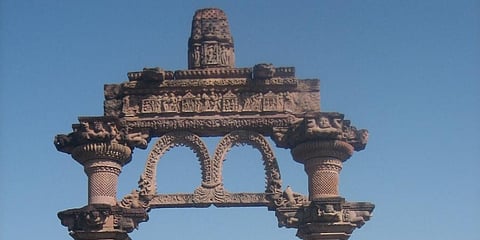

The landscape of India is dotted with many small towns and villages of great heritage value. However, their tourist potential is not adequately tapped. Cut off from the main tourist circuits, these remote places are rarely visited. Gyaraspur in Vidisha district of Madhya Pradesh is one such small town.
The place is named after gyaras, the eleventh day (Ekadashi) of the Hindu calendar month. As per a legend, the king of Vidisha practised strict Ekadashi-vrata and no one in his household took any food on that day. Once his son-in-law, Sobhana, visited the palace on Ekadashi; however, no one offered him any food. Tired from his journey and not getting any food, Sobhana died. But he was fully recompensed in the next world. Two or three years later, a brahmana took a halt at Gyaraspur. He witnessed a miracle in the night and saw Sobhana descending onto Earth and holding his court. Since then, the place started being called Gyaraspur, signifying the day Sobhana attained elevation to heaven. To remember this event, a large fair is organised on each Ekadashi in the town.
Gyaraspur was an important cultural and trade centre during the Pratihara period (9th–10th century CE). The town patronised all the major religions of that time and has three Hindu temples, one Buddhist stupa, one Jain temple and remains of scattered antiquities. All these monuments are placed between the 9th and 10th century CE. The antiquity of the town was known since 1875 after Alexander Cunningham described it in his reports. All the surviving monuments were in different stages of preservation, and most required immediate attention. However, it was only in the 1930s that conservation activities were taken up by the archaeology department of the Gwalior State.
The Bajra Matha complex is the best-preserved temple in the town. It is a unique triple-shrine temple consisting of three cells placed side by side in a row. The central shrine is dedicated to Surya and the subsidiary ones are for Shiva and Vishnu. Madhya Pradesh has many Surya temples of the Pratihara period; however, except Bajra Matha, the others are single-shrine temples. Bajra Matha represents the movement where Surya was given a prominent position in the Hindu pantheon.
The other two Hindu temples have survived partially. Known as Athkhamba (or eight pillars) by the locals is what is left of a large Siva temple. The temple consisted of a mandapa (hall), antarala (vestibule) and garbhagriha (sanctum). The lintels above the pillars are exquisitely carved and an image of Siva on the lalata-bimba (crest) of the garbhagriha doorway suggests that the temple was dedicated to Him. Chaukhambha (or four pillars) is what remains of a majestic Vishnu temple. The temple was adorned with an entrance portal, Hindola Torana. It was assumed to be a stand for a swing (hindola). The surviving four pillars are the remains of a large mandapa that once stood here. Images of Vishnu avataras over the torana and other Vaishnava images over the lintels of the pillars suggest the affiliation of the temple.
The Mala Devi temple is unique and comes under the rare category of partial rock-cut and partial structural temples. It is built on a slope of a hill, with a picturesque view of the lush green fields below. The northern ridge of the hill had a natural cavern that got sanctified and a temple was later constructed keeping that natural cavern as its garbhagriha. The temple is dedicated to a Jain Tirthankara, probably Adinatha, as evident by the presence of Yakshi Chakreshvari on the lalata-bimba. Another unique feature of the temple is the projecting balconies on its outer walls, making it one of the earliest temples with such a design.
A Buddhist stupa stands perched high on a hill near the town. It has lost its original structure due to remodelling during renovation. Four large Buddha images were placed at the cardinal points; these were removed to a local storeroom in Gyaraspur during restoration. The presence of this stupa suggests a Buddhist congregation at the site during the 9th–10th century CE.
The most impressive find from the town is the famous Gyaraspur Lady, now housed inside a secure vault of the Gujari Mahal Museum, Gwalior. The torso of the statue was collected from the debris of the Hindola Torana complex in 1933. A year later, the head of the statue was found. Both the pieces lay separately in the collection room for some time. A few years later while checking the collection, it was found that the head fit the torso—infusing life into the statue. Its real potential was realised later when Dr C Sivaramamurti categorised it as an unsurpassed piece of medieval art and a great masterpiece of all Indian art.
Situated on NH146 connecting Bhopal to Sagar, Gyaraspur awaits its transformation into a highway tourist attraction allowing travellers to get a glimpse of its architectural treasures.
Saurabh Saxena
Founder of Puratattva, a documentation of heritage sites
(Puratattva.India@gmail.com)